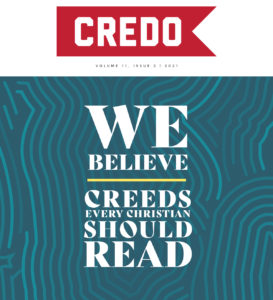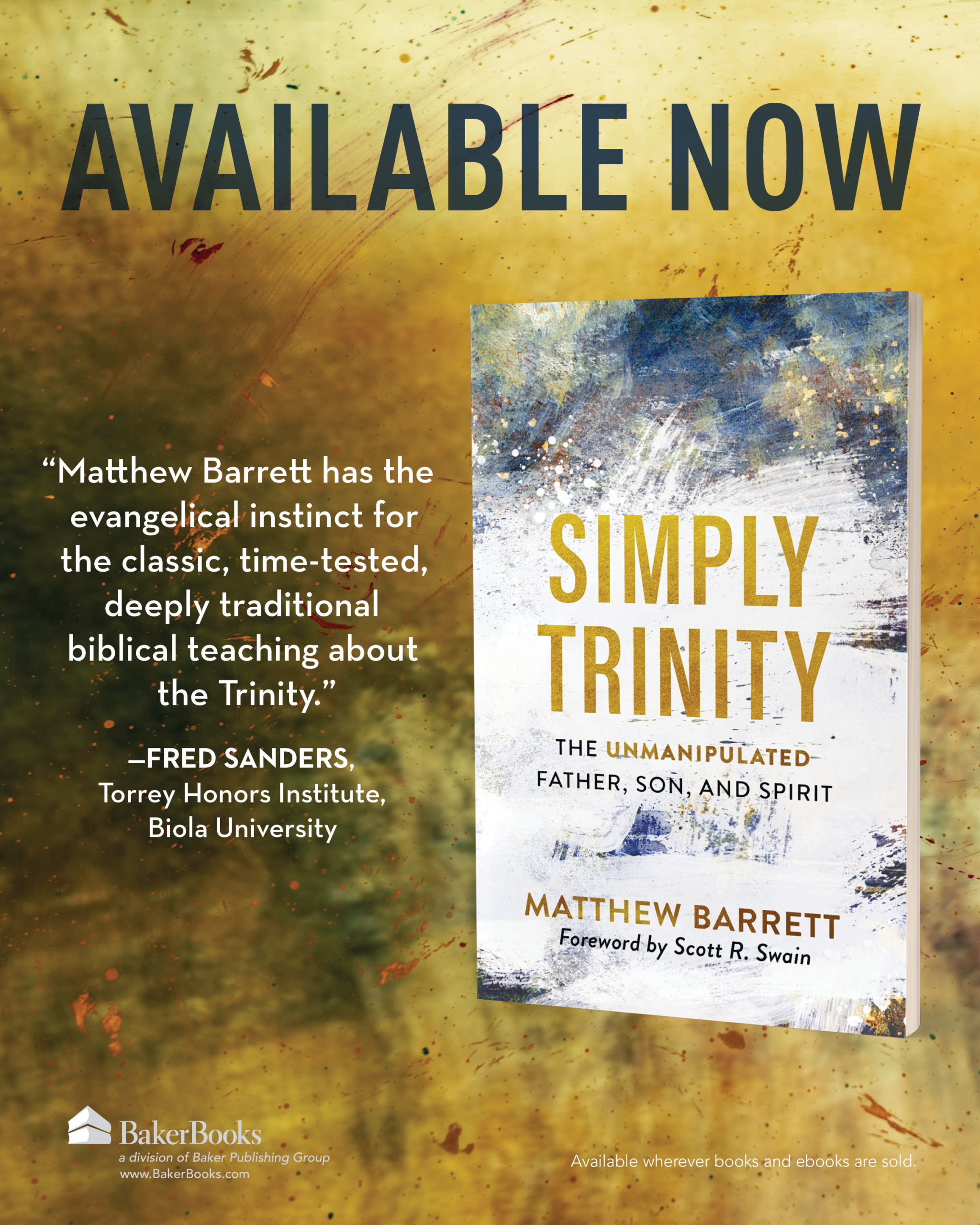
The Christian Creeds: An Introduction
T he new issue of Credo Magazine focuses on the creeds of the Christian Faith. The following is an excerpt from one of the issue’s featured columns by Rhyne R. Putman. Dr. Putman presently serves as associate vice president of academic affairs at Williams Baptist University in Walnut Ridge, Arkansas, and as associate professor of theology at New Orleans Baptist Theological Seminary.
he new issue of Credo Magazine focuses on the creeds of the Christian Faith. The following is an excerpt from one of the issue’s featured columns by Rhyne R. Putman. Dr. Putman presently serves as associate vice president of academic affairs at Williams Baptist University in Walnut Ridge, Arkansas, and as associate professor of theology at New Orleans Baptist Theological Seminary.
From the very beginning, creeds and creedal formulations have played a crucial role in the beliefs and practices of Christian churches. Some Christians (usually in free church traditions) deny the creeds any authority in teaching or value in worship. But this rejection of tradition usually stems from a misunderstanding of the function of the creeds and the classical Protestant understanding of sola Scriptura. Creeds have no independent “authority” on their own, but they are “authoritative” or normative to the degree that they faithfully represent what Scripture teaches.[1] As faithful interpretations of Scripture, creeds can be a tremendous asset to us today.
Creeds are in the Bible
The creeds may have been formulated centuries after the last books of the Bible were written, but there are numerous models for creedal formulations within Scripture. Consider the numerous passages in Scripture that  summarize and profess the faith of Israel and the early church in creedal forms. The Shema (Deut. 6:4–5) was a simple, concise profession of Israel’s faith: “Listen, Israel: The Lord our God, the Lord is one. Love the Lord your God with all your heart, with all your soul, and with all your strength.”[2] This pronouncement declared the uniqueness of Israel’s God and the mandate of his people. The psalter contains liturgical formulas like “his faithful love endures forever” (Ps. 100:5; 106:1; 118:1–29; Ps. 136:1–26) which helped ingrain Israel’s faith into the hearts of their hearers. New Testament epistles contain early hymns to Christ that served an important liturgical function in the early church (Phil. 2:6–11; Col. 1:15–20; 1 Tim. 3:16).[3] Given these biblical precedents, it should not surprise us that the early church replicated this pattern in her own expressions of faith and worship.
summarize and profess the faith of Israel and the early church in creedal forms. The Shema (Deut. 6:4–5) was a simple, concise profession of Israel’s faith: “Listen, Israel: The Lord our God, the Lord is one. Love the Lord your God with all your heart, with all your soul, and with all your strength.”[2] This pronouncement declared the uniqueness of Israel’s God and the mandate of his people. The psalter contains liturgical formulas like “his faithful love endures forever” (Ps. 100:5; 106:1; 118:1–29; Ps. 136:1–26) which helped ingrain Israel’s faith into the hearts of their hearers. New Testament epistles contain early hymns to Christ that served an important liturgical function in the early church (Phil. 2:6–11; Col. 1:15–20; 1 Tim. 3:16).[3] Given these biblical precedents, it should not surprise us that the early church replicated this pattern in her own expressions of faith and worship.
Creeds summarize the grand narrative of Scripture
Yes, some of the creeds do employ philosophical concepts, but they are not mere abstractions rooted in speculative contemplation. Instead, as N. T. Wright astutely observes, creeds are “portable narratives” that
consciously tell the story—precisely the scriptural story!—from creation to new creation, focusing particularly, of course, on Jesus and summing up what Scripture says about him in a powerful, brief narrative (a process that we can already see happening within the New Testament itself). When the larger story needs to be put within a particular discourse, for argumentative, didactic, rhetorical, or whatever other purpose, it makes sense, and is not inimical to its own character, to telescope it together and allow it, suitably bagged up, to take its place in that new context—just as long as we realize that it will collect mildew if we leave it in its bag forever.[4]
While they are not meant to be substitutes for Scripture, the creeds do model for us a succinct way of talking about the whole biblical storyline of creation, fall, redemption, and restoration. The Apostles’ Creed is a clear example of this kind of discourse:
I believe in God the Father almighty, creator of heaven and earth,
and believe in Jesus Christ, his only Son, our Lord,
who was conceived from the Holy Spirit and born of the Virgin Mary,
who suffered under Pontius Pilate, was crucified, died, and was buried,
descended into hell, rose again from the dead on the third day,
ascended into heaven and is seated at the right hand of the Father,
who will come again to judge the living and the dead.
I believe in the Holy Spirit,
the holy Catholic Church, the communion of saints,
the forgiveness of sins,
the resurrection of the body,
and the life everlasting. Amen.
The creed begins with the beginning of the story—God is “creator of heaven and earth”—and ends with the end of the story—the Son is coming again “to judge the living and the dead,” bringing with him “the resurrection of the body” and “life everlasting.” While it does not explicitly describe the Fall, it does speak of “the forgiveness of sins” needed because of human fallenness. It does not directly address the history of Israel, but it does shout about Israel’s Messiah who fulfills the promises given to Israel.
Creeds explain biblical revelation
Christians are often curious why we value creeds so much when Scripture itself is a clear and sufficient authority for faith and practice. While Scripture is the supreme source of divine revelation and the only norming norm for our faith, it still must be interpreted (Neh. 8:8; Acts 8:30–35). Individual readers interpret the Bible to make sense of its meaning. Sermons are interpretations of the biblical message that include explanation and application. The same is true of the early creeds: they are explanations of what the Bible says about Jesus Christ. We certainly don’t need the creeds to interpret Scripture, as the message of Scripture has an internal clarity that can be grasped with the illuminating aid of the Holy Spirit. However, the creeds are helpful guides that resulted from centuries of reflection on the biblical message.While Scripture is the supreme source of divine revelation and only norming norm for our faith, it still must be interpreted. Click To Tweet
The early church faced serious external challenges from heretical sects who, while giving lip service to biblical authority, undermined its meaning. So, how did they respond to those, like Arius, who used biblical prooftexts to make his case for his errant view of the Son? As R. P. C. Hanson explained, the “theologians of the Christian Church were slowly driven to a realization that the deepest questions which face Christianity cannot be answered in purely biblical language, because the questions are about the meaning of biblical language itself.”[5] Though the creeds used some conceptual language that would have been foreign to the human authors of Scripture (i.e., homoousion), they expressed the same judgments made by biblical authors. The Nicene Fathers made the same judgment about Jesus as Paul did—that he is truly equal to God and worthy of devotion and service (Phil. 2:5–11)—but did so using philosophical categories that would have been familiar to their context.[6]
*Read the remainder of Dr. Putman’s article here.
Endnotes
[1]. See Rhyne R. Putman, “Baptists, Sola Scriptura, and the Place of the Christian Tradition,” in Baptists and the Christian Tradition: Towards an Evangelical Baptist Catholicity, edited by Matthew Y. Emerson, Christopher W. Morgan, and R. Lucas Stamps (Nashville: B&H Academic, 2020), 27–54.
[2]. A helpful overview of these biblical creedal formulations can be found in Michael F. Bird, What Christians Ought to Believe: An Introduction to Christian Doctrine through the Apostle’s Creed (Grand Rapids: Zondervan, 2016), 19–21.
[3]. Steven E. Fowl, The Story of Christ in the Ethics of Paul: An Analysis of the Function of the Hymnic Material in the Pauline Corpus, JSNTSS 36 (Sheffield: Sheffield Academic Press, 1990).
[4]. N. T. Wright, “Reading Paul, Thinking Scripture,” in Scripture’s Doctrine and Theology’s Bible: How the New Testament Shapes Christian Dogmatics, ed. Markus Bockmuehl and Alan J. Torrance (Grand Rapids: Baker, 2008), 64.
[5]. R. P. C. Hanson, The Search for the Christian Doctrine of God: The Arian Controversy, 318-381 (London/New York: T&T Clark, 1988), xxi.
[6]. David S. Yeago, “The New Testament and Nicene Dogma: A Contribution to the Recovery of Theological Exegesis,” in Theological Interpretation of Scripture: Classic and Contemporary Readings, ed. Stephen E. Fowl (Cambridge, MA: Blackwell, 1997), 93.

